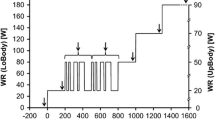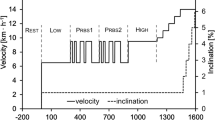Summary
The purpose of this study was to determine the effect of fitness and work level on the O2 uptake and CO2 output kinetics when the increase in work rate step is adjusted to the subject's maximum work capacity. Nine normal male subjects performed progressive incremental cycle ergometer exercise tests in 3-min steps to their maximum tolerance. The work rate step size was selected so that the symptom-limited maximum work rate would be reached in four steps at 12 min in all subjects. Oxygen consumption (VCO2) and carbon dioxide production VCO2 were calculated breath by breath. For the group, the time (mean, SEM) to reach 75% of the 3-min response (T 0.75) for VO2 increased significantly (P<0.01) at progressively higher work rate steps, being 53.3 (5.5) s, 63.5 (4.6) s, 79.5 (5.0) s, and 94.5 (5.8) s, respectively. In contrast, T 0.75 for VCO2 did not change significantly [74.9 (7.4) s,. 75.6 (5.0) s, 85.1 (5.3) s, and 89.4 (6.3) s, respectively]. VCO2 kinetics were slower than VO2 kinetics at the low fractions of the subjects' work capacities but were the same of faster at the high fractions because of the slowing of VO2 kinetics. The first step showed the fastest rise in VO2. While VO2 kinetics slowed at each step, they were faster at each fraction of the work capacity in the fitter subjects. The step pattern in VO2 disappeared at high work rates for the less fit subjects. The heart rate response paralleled that of VO2. We conclude that VO2 and VCO2 kinetics are slower in the less fit subjects but only VO2 kinetics are significantly attenuated in response to proportional step increases in work rate.
Similar content being viewed by others
References
Beaver WL, Wasserman K, Whipp BJ (1973) On-line computer analysis and breath-by-breath graphical display of exercise function tests. J Appl Physiol 34:128–132
Beaver WL, Wasserman K, Whipp BJ (1986a) A new method for detecting anaerobic threshold by gas exchange. J Appl Physiol 60:2020–2027
Beaver WL, Wasserman K, Whipp BJ (1986b) Bicarbonate buffering of lactic acid generated during exercise. J Appl Physiol 60:472–478
Casaburi R, Barstow TJ, Robinson T, Wasserman K (1989) Influence of work rate on ventilatory and gas exchange kinetics. J Appl Physiol 67:547–555
Cerretelli P, Sikand R, Farhi LE (1966) Readjustments in cardiac output and gas exchange during onset of exercise and recovery. J Appl Physiol 21:1345–1350
Diamond LB, Casaburi R, Wasserman K, Whipp BJ (1977) Kinetics of gas exchange and ventilation in transition from rest or prior exercise. J Appl Physiol 43:704–708
Hagberg JM, Nagle FJ, Carlson JL (1978) Transient O2 uptake response at the onset of exercise. J Appl Physiol 44:90–92
Hickson RC, Bonze HA, Holloszy JO (1978) Faster adjustments of oxygen uptake to the energy requirements of exercise in the trained state. J Appl Physiol 44:877–881
Hughson RL, Morrissey MA (1982) Delayed kinetics of respiratory gas exchange in the transition from prior exercise. J Appl Physiol 52:921–929
Karlsson J, Nordesjo L-O, Jorfeldt L, Saltin B (1972) Muscle lactate, ATP, and CP levels during exercise after physical training in man. J Appl Physiol 33:199–203
Karlsson H, Lindborg B, Linnarson D (1975) Time courses of pulmonary gas exchange and heart rate changes in supine exercise. Acta Physiol Scand 95:329–340
Linnarsson D (1974) Dynamics of pulmonary gas exchange and heart rate changes at start and end of exercise. Acta Physiol Scand 415 [Suppl]:1–68
Wasserman K, Hansen JE, Sue DY, Whipp BJ (1986) Principles of exercise testing and interpretation. Lea & Febiger, Philadelphia, p 31
Whipp BJ (1971) Rate constant for the kinetics of oxygen uptake during light exercise. J Appl Physiol 30:261–263
Whipp BJ, Wasserman K (1972) Oxygen uptake kinetics for various intensities of constant load work. J Appl Physiol 33:351–356
Whipp BJ, Wasserman K, Davis JA, Lamarra N, Ward S (1980) Determinants of O2 and CO2 kinetics during exercise in man. In: Ceretelli P, Whipp BJ (eds) Exercise bioenergetics and gas exchange. Elsevier, Amsterdam, pp 175–185
Winder WW, Hickson RC, Hagberg JM, Ehsani AA, McLane JA (1979) Training-induced changes in hormonal and metabolic responses to submaximal exercise. J Appl Physiol 46:766–771
Author information
Authors and Affiliations
Rights and permissions
About this article
Cite this article
Zhang, YY., Johnson, M.C., Chow, N. et al. The role of fitness on VO2 and VCO2 kinetics in response to proportional step increases in work rate. Eur J Appl Physiol 63, 94–100 (1991). https://doi.org/10.1007/BF00235176
Accepted:
Issue Date:
DOI: https://doi.org/10.1007/BF00235176




